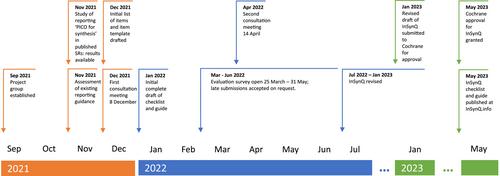Development of the InSynQ checklist: A tool for planning and reporting the synthesis questions in systematic reviews of interventions
Abstract
Introduction
Methods guidance and appraisal tools for systematic reviews require specification of the question and eligibility criteria for the review (“PICO for the review”). Less emphasis has been given to specifying the question and criteria for each synthesis (“PICO for each synthesis”), yet decisions about which studies to include in each synthesis can critically influence the utility and findings of a review. This paper describes the rationale and methods for developing the InSynQ (Intervention Synthesis Questions) tool for planning and reporting synthesis questions in reviews of interventions. The aim is to provide transparency about the basis of the tool and contribute to evidence on methods for developing guidance for research conduct and reporting.
Methods
Informed by EQUATOR Network methods, we (1) established a project group; (2) examined reporting of the “PICO for each synthesis” in published reviews; (3) reviewed existing reporting guidance and the Cochrane Handbook for Systematic Reviews of Interventions; (4) drafted items with elaboration, explanation, and examples; (5) conducted consultation meetings, an evaluation survey and pilot test; (6) incorporated feedback.
Results
Existing reporting guidelines do not distinguish the review and synthesis PICO, with limited coverage of the elements needed to specify the PICO for each synthesis. Using the PRISMA 2020 format, the draft tool contained 10 items with essential and additional reporting elements, explanations, and examples. Revisions arising from consultation meetings (>30 people), included adding an eleventh item on consumer and stakeholder involvement, a figure explaining PICO for each synthesis, and integrating examples into elements/explanations. All respondents to the survey (12 people) said the tool would help them plan or appraise synthesis questions. InSynQ is available at https://InSynQ.info.
Conclusion
Transparent reporting of the development process contributes to the evidence base for methods to develop guidance. It may improve uptake of InSynQ, in turn enhancing the clarity of syntheses.


 求助内容:
求助内容: 应助结果提醒方式:
应助结果提醒方式:


